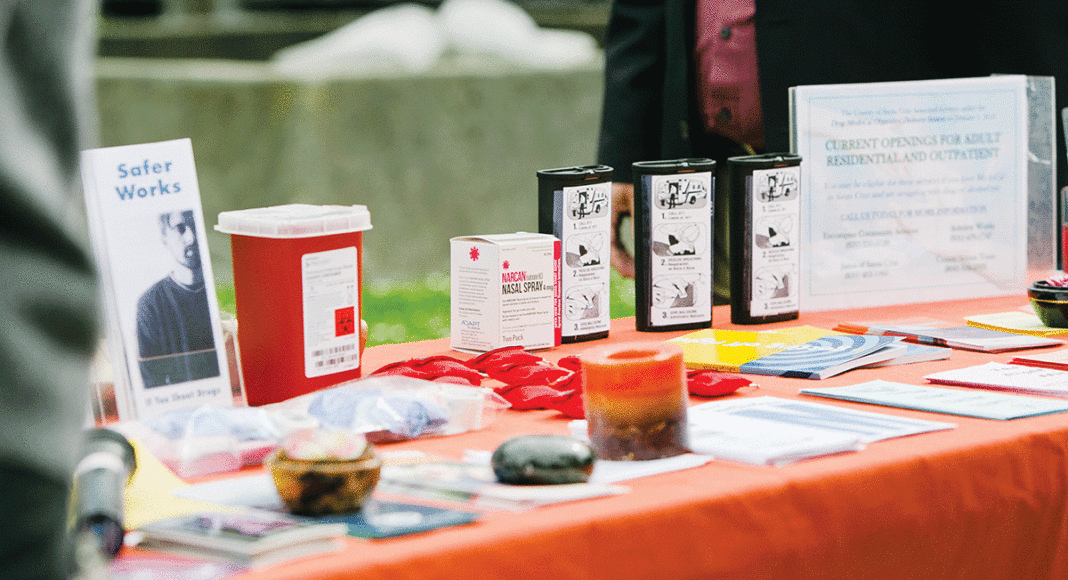One afternoon in September 2010, I was sorting plastic bottles for a man with a bedraggled beard who needed cash.
This was in Portland, Oregon, and I was working a grocery store job that I was thrilled to have, given that autumn’s lackluster economic recovery in the shadow of the Great Recession.
I was reaching into a shopping cart and tossing the bottles into various bins when I felt a prick on my fingertip and noticed a squirt of blood. In the bottom of the shopping cart, I spotted a dirty syringe. I gave a cash voucher to the man who’d brought the bottles in and told him he had some nerve leaving a used needle in a cart that he was passing over to me. He told me that he had no idea what I was talking about, that the needle wasn’t his.
“Hey, you should get yourself tested!” he shouted as I stormed back to the supermarket’s main building.
“Oh, ya think?” I yelled back.
Thankfully, the tests for Hepatitis and HIV came back negative.
Thinking back on the experience reminds me of a few lessons relevant to the debate over Santa Cruz County’s Syringe Services Program (SSP), also known as the needle exchange, which aims to prevent disease spread among injection drug users. First, the issues surrounding syringe waste are far from a Santa Cruz-only problem. That’s something supporters of syringe distribution have been keen to point out over the years.
Another is that the risk of contracting a disease like HIV from a crusty needle is nearly nonexistent. It was something I knew at the time of my supermarket run in, and why it ultimately took me several months to get my final round of tests. But I was still scared, at least until I knew for sure that all the results were negative.
While the Santa Cruz County Board of Supervisors debated possible changes to the needle exchange earlier this month, District 3 Supervisor Ryan Coonerty said that accidental needle sticks have grown to be a health problem, and that public fear continues to grow. The county is over-emphasizing the aim of reducing the spread of disease, he said, at the expense of a separate goal to reduce litter. Coonerty added that the county should have a goal of no needles in public spaces. Parents and grandparents come up to him, he explained, and say that they will no longer take their kids to many public spaces because they saw a needle, or heard about one, at a beach or a park or a library.
“As the father of young children, there is no conversation I can have where, if my child steps on a needle, it’s OK because the relative chances of disease are small,” Coonerty, the board chair, said at a June 11 meeting.
SKIN DEEP
This month, supervisors voted 5-0 to take action on changes to the needle exchange program, including initiating a study to learn more about the actual number of needles the county is distributing—and how many it gets back. Supervisor Bruce McPherson noted that the number of unique individual clients has fallen 40% over the last four years, even while the number of syringes distributed has nearly tripled.
Part of that shift comes from a local group of volunteers called the Harm Reduction Coalition of Santa Cruz County, which gets needles from the SSP and distributes them off-site to a community of injection drug users. The coalition has been fending off controversy over its efforts, and though it filed an application with the state to expand services and create an official mobile exchange in Santa Cruz County that would be certified by California’s health department, it has since been withdrawn.
The Board of Supervisors also supported installing more syringe disposal kiosks throughout the county, with the approval of local cities. Coonerty will write a letter to neighboring jurisdictions about the proposal. After staff presents more analysis this fall, supervisors will look at making other changes, including possibly regulating the Harm Reduction Coalition’s independent exchanges and limiting the number of needles that individuals, including volunteers, can pick up from the county. To compensate, the board may expand the number of hours that the county’s SSP is open.
Over the past couple of years, the county has taken in 50% more needles, including the syringes collected at kiosks, than it has given out. Coonerty noted that when the Ross homeless encampment closed down, there were hundreds of needles on the ground and in the San Lorenzo River area, even though there was a kiosk just yards away.
He also called that the Coral Street area, where the Harm Reduction Coalition has been running needle distributions “a public policy failure,” since it’s near educational and summer programs. He compared it to “an open-air drug market.”
DEALING WITH IT
Research has not shown that more tightly regulated exchanges actually reduce litter waste.
Denise Elerick, the leader of the Harm Reduction Coalition, says needle litter does worry her, but she says that by keeping infections from spreading, syringe access reduces the risk that a given needle, discarded or not, will carry disease.
Arnold Leff, the county’s recently retired health services officer, says that the Harm Reduction Coalition has filled a major void after the county began cutting back hours for syringe distribution at its Emeline health campus.
“The majority of people who inject drugs today will not be injecting drugs in 10 years, if they survive,” says Leff, who retired at the end of May. “We need to recognize that a lot of these people who use drugs are our family members. And if we don’t provide safe treatment, they will develop Hepatitis C or HIV or something like [them], and that will spread into the community. Once they get over the hump, they can become tax-paying citizens. We need to help them get over the hump and also prevent them from doing personal damage.”
County administrators picked Leff’s successor Gail Newel, who the Board of Supervisors approved and who will step into her new role July 1.
On Sunday evenings in the Harvey West neighborhood, Ruthy, an injection drug user who asked GT not to use her last name, has been going to Coral Street near the Homeless Services.
There, she meets with the Harm Reduction Coalition and gets clean syringes, sanitizing pads, a hot meal, and a hug. She says that she never would have shown up to the county’s official SSP hub at the Emeline Avenue health clinic for fear that she might get hassled by cops or public safety activists. Since she started going to the needle exchange, she’s learned not to reuse needles, even on her own body, because it can create abscesses.
The abscesses she previously had on her body have now healed. For users like her, she says the exchange is the first step toward taking care of themselves, and hopefully getting clean.
“When you’re making these small moves to take care of yourself,” she says, “it changes into you wanting to take care of yourself even more.”














Sounds like Santa Cruz may benefit from a safe injection site even though they probably don’t have the political will to do it.
Anthony, sounds like an absolute need and Santa Cruz. But it’ll never happen due to “safety activists“ with misinformed rhetoric and the board of supervisors Believe in every word they say. These safety activists are actually harmful to the general public in the information that they spread not being correct based upon CDC and local public health policy. These safety activists are groups such as takeback Santa Cruz and Santa Cruz united etc.
“…due to “safety activists“ with misinformed rhetoric…” That I believe. Thank you for sharing about Take Back Santa Cruz. I didn’t know about them. It seems there are many groups out there have the appearance of being forward thinking but in reality are doing more harm than good in some aspects of creating healthier communities. San Francisco is at the same crossroads Santa Cruz is in. Unless we start to steps in that direction, nothing will change. Science and facts don’t lie.
Since 2015, syringes have been legal for adults to purchase and possess without fear of arrest at around .50 cents at local pharmacies. No prescription needed. If you choose to shoot up dope, there are no excuses to not PACK your NEEDLES and dispose of them. This is the one of the first steps in caring about yourself and your community. Which includes children who don’t need to swirl a dirty orange cap in their mouth at the beach or slide down the slide at SLV Park and get poked in the belly by an uncapped syringe.
We give out more needles in Santa Cruz County than most others and our local Hepatitis and HIV rates cannot be correlated to any program because nobody has bothered to link them to actual real data. Meaning, we can’t say how many clients who utilize the County Program are actually tested and followed up with treatment of they are found to be positive. Nor can Denise Elerick provide any meaningful data and her fraudulent application to the State was withdrawn because it had zero support from the local progressive community.
Good Times you disappoint me. Stick to the facts and save the rhetoric for The City on a Hill kids.
The topic of public health and syringe services has become about politics and donors rather than about the right thing to do which is to refer to science and data. A state wide movement to place decisions about syringe programs be given to local jurisdiction failed and Santa Cruz County is a great example of why this decision should be made by California Department of Public Health and not bureaucrats and politicians. We have elected officials who think they need to re invent the wheel and come up with a design for a program to minimize syringe litter. It has been done. Low barrier needs based connection meeting people where they are. Let Health Services Agency do their job
Needle disposal /collection should happen at all public restrooms. Disneyland/ Disneyworld have metal syringe deposit boxes in bathrooms.
Access to clean needles is right for public wellness and reducing disease. Asking people to carry/ collect and exchange used syringes is ludicrous and dangerous.